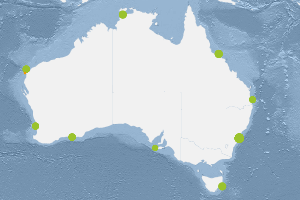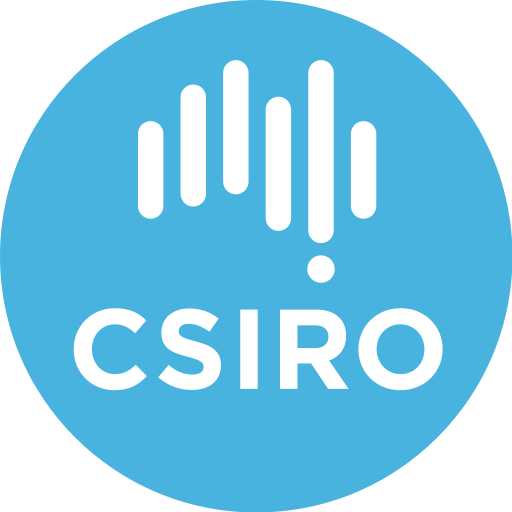Type of resources
Topics
Keywords
Contact for the resource
Provided by
Years
Formats
Representation types
Update frequencies
Status
draft
-
This dataset contains data collected by the Australian Continuous Plankton Recorder (AusCPR) survey and is funded by IMOS (Ships of Opportunity sub-facility) and CSIRO. The aims of the AusCPR survey are to: * map plankton biodiversity and distribution * develop the first long-term plankton baseline for Australian waters * document plankton changes in response to climate change * provide indices for fisheries management * detect harmful algal blooms * validate satellite remote sensing * initialise and test ecosystem models. The survey conducts repeat tows in the GBR, the East Australian Current and down to the Southern Ocean Time Series Mooring (SOTS). Other routes are conducted on an adhoc nature around Australia. The dataset also contains phytoplankton data from the UTAS / AAD led Southern Ocean CPR (SOCPR) project which is also funded by IMOS. The datasets available in this collection include Phytoplankton Colour Index (an estimate of chlorophyll in the water), phytoplankton abundance, zooplankton abundance and a biomass index from AusCPR and phytoplankton abundance from SOCPR. This data are freely available through the AODN portal: https://portal.aodn.org.au. This data is freely available but please acknowledge all relevant parties, as detailed in acknowledgement section.
-

This dataset comprises the phytoplankton abundance and biovolume estimates as part of a broader sampling program carried out at the Southern Ocean Time Series, a facility within the Integrated Marine Observing System (IMOS). The primary focus is sustained observing of ocean properties and processes important to climate, carbon cycling, and ocean productivity. Regular phytoplankton samples are collected at approximately 14 day intervals (exact intervals and seasonal coverage dependent on deployment length). The moorings are serviced annually, at which time the existing moorings are recovered and new moorings are deployed. Water samples from within the surface mixed-layer are collected at pre-programmed intervals using a Remote Access Sampler, in pairs about 1 hour apart. One sample in each pair is preserved for phytoplankton community composition by microscopy, and the other sample is preserved and used for accompanying chemical analysis of nutrients, total dissolved inorganic carbon (DIC) and alkalinity. Each sample is collected from within the surface mixed-layer at 32 m depth (2010 - 2017) or 5 m depth (2018-current) depending on the design of the mooring surface assembly and instrumentation. Typically a maximum of 24 samples are collected over an annual deployment cycle. The samples collected are analysed for: 1. Community composition / abundance (cells/L) 2. calculated biovolume (um3/L). Protocols for the phytoplankton time-series are described in Eriksen et al (2018), and the annual sample reports for each deployment. Data storage and access is planned to be interoperable with other national and international programs through the IMOS Infrastructure. Station metadata can be found through this resource. Data is available freely via the AODN portal: https://portal.aodn.org.au. As the taxonomic resolution of the data has changed over time, due to continual training, it is important that users refer to the change log tables included in your data download. These will provide information on the validity of the taxa, from what date we have been identifying certain taxa etc. Classification fields may be blank depending on the level to which that taxa has been identified, i.e. if only identified to family, genus and species will be blank.
-
This record contains data collected from the near-water surface sampling site off the Lucinda Jetty, as part of the Lucinda Jetty Coastal Observatory. Sample collection began the 9th of January, 2014. The data can be used for Ocean Colour sensor validation. Parameters measured include the absorption coefficients of the particulate and dissolved components of the water column and the phytoplankton pigment concentration and composition.
-
This dataset shows the global distribution of seagrasses, and is composed of two subsets of point and polygon occurence data. The data were compiled by UNEP World Conservation Monitoring Centre in collaboration with Dr Frederick T. Short (University of New Hampshire, USA).
-

Sounding data extracted from: Continental Shelf Research 21 (2001) 157–201 Geochemistry and particle size of surface sediments of Exmouth Gulf, Northwest Shelf, Australia G.J. Brunskill,*, A.R. Orpin, I. Zagorskis, K.J. Woolfe, J. Ellison DOI: 10.1016/S0278-4343(00)00076-5 Project Details: The Pilbara Marine Conservation Partnership (PMCP) was an initiative designed to enhance the net conservation benefits of the globally-significant coral reef ecosystems of the Pilbara (Western Australia) by providing an assessment of the condition and trajectory of key ecological values. These assessments were designed to inform and complement existing governance and management arrangements and the PMCP is intended to provide ongoing advice and assessment for conservation efforts in the region, providing lasting benefits. The PMCP concept is based on three core ecological components, namely: Coral Reef Health - concentrating mainly on habitat forming primary producers. Fish and Sharks - their community structure, interactions and impacts on lower trophic levels. Environmental Pressures - physical and anthropogenic factors that influence the condition of reefs and associated biota.
-
The Flinders Commonwealth Marine Reserve (CMR) survey was a pilot study undertaken in August 2012 as part of the National Marine Biodiversity Hub's National monitoring evaluation and reporting theme. The aim of this theme is to develop a blueprint for the sustained monitoring of the South-east CMR Network. The particular aims of the survey were twofold; 1) to contribute to an inventory of demersal and epibenthic conservation values in the reserve and 2) to test methodologies and deployment strategies in order to inform future survey design efforts. Several gear types were deployed; including multibeam sonar, shallow-water (less than 150m) Baited Remote Underwater Video Systems (BRUVS), deep- water BRUVS (to 600 m), towed video and digital stereo stills. This resource contains the deep-water BRUVS footage captured on the slope (~500m depth) of two sites: the Flinders CMR and the adjacent Cape Barren fisheries closure. At each site 3 stereo deepBRUVS were deployed over a 3-day period, during which they recorded between 11 and 15 1-hour sampling events each.
-
This dataset shows the global distribution of coral reefs in tropical and subtropical regions. It is the most comprehensive global dataset of warm-water coral reefs to date, acting as a foundation baseline map for future, more detailed, work. This dataset was compiled from a number of sources by UNEP World Conservation Monitoring Centre (UNEP-WCMC) and the WorldFish Centre, in collaboration with WRI (World Resources Institute) and TNC (The Nature Conservancy). Data sources include the Millennium Coral Reef Mapping Project (IMaRS-USF and IRD 2005, IMaRS-USF 2005) and the World Atlas of Coral Reefs (Spalding et al. 2001). Purpose IMaRS-USF was funded by the Oceanography Program of NASA (National Aeronautics and Space Administration) to provide an exhaustive worlwide inventory of coral reefs using high-resolution satellite imagery, under the framework of the Millenium Coral Reef Mapping Project. As a fully validated Millennium Coral Reef Mapping Project product was not available at the global scale, there was a need to create an 'interim' global amalgamated map product. The dataset was hence created to further mobilise the Millennium Coral Reef Mapping Project products and their validation.
-

This record describes multibeam echosounder data collected on RV Investigator voyage IN2018_C01, 'RAN Hydrographic Survey' which departed Hobart on the 28th May 2018 and returned to Hobart on the 8th June 2018. The overall focus for this survey was to conduct a modern survey in the primary shipping route through Bass Strait and to To facilitate safe navigation for international and coastal shipping. The Kongsberg EM710 MKII multibeam echosounder was used to acquire seafloor bathymetry and backscatter information (and watercolumn backscatter) near Wilson's Promontory in Bass Strait and during the transit from and to Hobart. The EM710 MKII provides a 0.5° by 1° transmit and receive angular resolution respectively. The echosounder's nominal frequency range is from 40 to 100 kHz. Data are stored in *.all raw format for bathymetry and backscatter and *.wcd format for watercolumn backscatter at CSIRO. There are 372 files totalling 119 GB of raw bathymetry & backscatter data, and 241 files totalling 269 GB of raw watercolumn data in this dataset. Sound velocity profiles were applied to this data during data acquisition. Bathymetry data contained in *.all format are corrected for motion and position. Tide corrections were applied to the processed data. Processed data has had outliers removed. Processed line data are available in *.gsf and ascii format, and processed bathymetry and backscatter grids in geotiff format. Additional information regarding this dataset, including further information on processing streams, is contained in the GSM data acquisition and processing report. Additional data products may be available on request.
-
This dataset represents Exclusive Economic Zones (EEZ) of the world. Up to now, there was no global public domain cover available. Therefore, the Flanders Marine Institute decided to develop its own database. The database includes two global GIS-layers: one contains polylines that represent the maritime boundaries of the world countries, the other one is a polygon layer representing the Exclusive Economic Zone of countries. The database also contains digital information about treaties. Please note that the EEZ shapefile also includes the internal waters of each country http://www.marineregions.org/eezmethodology.php
-

As part of the Pilbara Marine Conservation Partnership (PMCP), coral reef surveys of reef macroalgae species (including seagrasses) were undertaken between northern Ningaloo and the Dampier Archipelago. This dataset contains biomass estimates (g DW m-2 and g WW m-2) of macrophytes collected in shallow reef areas in the Pilbara region during two sampling trips: November 2013 and May 2014. Surveys were undertaken using using SCUBA at depths between 2-13m, with macroalgae and seagrasses identified to the lowest possible taxonomic level. The data include: * Macroalgae and seagrass diversity (0.25 square metre quadrats) * Macroalgae and seagrass species composition and biomass per quadrat (0.25 square metre) These data were collected to estimate macrophyte biomass in shallow reef areas across the Pilbara region in two contrasting seasons. These data are an output of the Pilbara Marine Conservation Partnership (PMCP) Coral Reef Health Theme.
